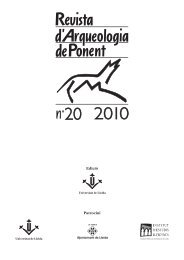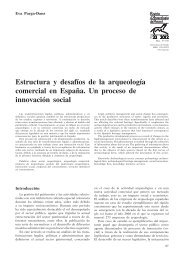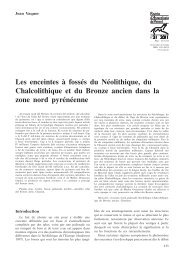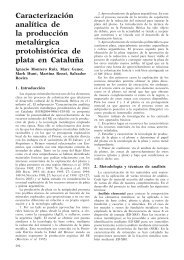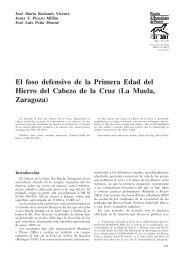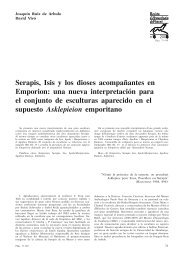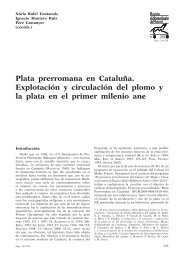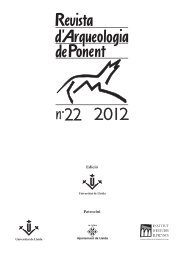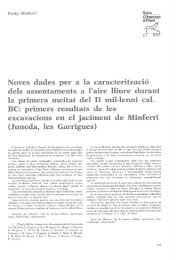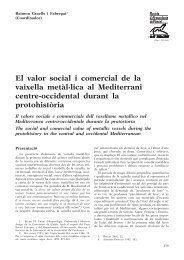RAP 18.1.indd - Revista d'Arqueologia de Ponent
RAP 18.1.indd - Revista d'Arqueologia de Ponent
RAP 18.1.indd - Revista d'Arqueologia de Ponent
You also want an ePaper? Increase the reach of your titles
YUMPU automatically turns print PDFs into web optimized ePapers that Google loves.
products (e.g., olive oil, wine), through this fluvialroute and with the Mediterranean sea.An assessment within the frameworkof the Iberian PeninsulaThe role of sheep as long-distance seed-dispersalvectors of several plant species by means of seedsand propagules transported on the fur and in thegut has been shown in the last few years (Fi s c h e r etal. 1996, Ma n z a n o et al. 2005, Mo u i s s i e et al. 2005,Man z a n o & Ma l o 2006). In fact, seeds attached tothe fur of nowadays traditional nomadic sheep herdsin Spain can be transported over hundreds of kilometresin this way (Ma n z a n o & Ma l o 2006).Seed attachment to sheep fur is often higher thanthat of goats, dogs associated to herds and herdsmen’sclothing. Even seeds and other plant parts withoutapparent structures for attachment can be found onthe fur of these animals, especially when they lieon the ground to rest or to give birth. Nevertheless,goats consume large amounts of seedlings and leavesof juvenile shrubs and trees. Thus, the role of goatsin mixed herds has been crucial to the <strong>de</strong>gradationof Mediterranean woodland.In general, palaeontological data show that domesticsheep breeds during the first millennium B.C. weresmaller and lower than the current sheep varieties(Pe l l ó n 2006). Thus, these ancient breeds browsedcloser to the ground and could collect and transportmore propagules attached to their fur than the currentlarger varieties.Wool was an important product for the inhabitantsof Europe and the Middle East during <strong>de</strong> firstmillennium B.C., and it is probable that both thePhoenicians and the Romans actively transportedsheep herds between Africa and Southern Europe,by ship (Pe l l ó n 2006, Pe r e i r a et al. 2006). In suchcircumstances seed transport across the MediterraneanSea probably promoted the expansion of thedistribution areas of several plant species associatedto sheep herds between both continents.On the other hand, the harvesting of wood tobe used as fuel in iron and ceramic manufacturingplayed an important role in landscape transformationprocesses in European Mediterranean lands. Smeltingiron and lime needs high temperatures and thereforelarge amounts of wood as fuel. Thus, the archaeologicalsites and remains found in Abrera suggest largeanthropogenic impacts in native vegetation during theIron Age and the Roman period (Gu i x et al. 2001).Large anthropogenic landscape changes in theIberian Peninsula were associated to the arrival ofnomadic herdsmen of sheep and goats, during theNeolithic, coming from the Eastern Mediterraneanregion. In fact, several ritual burials containing domesticsheep and goat remains thought to be datedbetween 425 and 300 B.C. were found in the Iberiansettlement of Penya <strong>de</strong>l Moro (Parc <strong>de</strong> Collserola,Sant Just Desvern), 19 km from Abrera (Ba r b e r à &Mo l i s t 2002). The transition from nomadic herding(Bronze Age) to cereal based agriculture and nonnomadicherding (Iberians —Iron Age— and Romantimes) probably increased landscape transformation inseveral Mediterranean areas of the Iberian Peninsula.Nevertheless, transhumant herding systems and se<strong>de</strong>ntaryagro-pastoral systems that inclu<strong>de</strong>d small-scaleseasonal movements of herds probably coexisted inthe Iberian Peninsula during, at least, the last 2,500years (Wainwright & Th o r n e s 2004).Current results suggest that the expansion of steppeand grassland vegetation in the Iberian Peninsuladuring the last 3.000 years were associated with theincrease of three related processes during the IronAge and Roman times: (a) wood-cutting for iron,lime and ceramic manufacturing; (b) anthropogenicfires for pasture creation/renovation and cereal cultivation;and (c) seed dispersal by sheep (includingplants from Eastern Europe, Middle East, Asia andNorthern Africa). The intensification of sheep andgoat grazing favoured those plants that were unpalatable(e.g., Pinus spp.; Pinaceae) or toxic for theseanimals (e.g., Euphorbiaceae) and chamaephytic un<strong>de</strong>rshrubs and pseudo-steppe invasive vegetation. Otherwise,soil <strong>de</strong>gradation by overgrazing, during the lastthree centuries, could have induced new changes onvegetation and plant-herbivore equilibrium, favouringthe colonisation of neophytes (e.g., Xanthiumspinosum, Conyza spp., Asteraceae, from the NewWorld; fig. 3).At the end of the last ice age (18.000 years ago),the Iberian Peninsula was dominated by temperateand montane steppes (mainly short-grass steppe and<strong>de</strong>nse tall-grass steppe; Ad a m s & Fa u r e 1998). Despitethe fact that the last ice age finished 14,000 yearsago, the Iberian Peninsula has been subject to otherminor climatic fluctuations that have influenced plantcommunities and plant distributions during the last10.000 years. During the first half of the Holocene(10.000-6.000 years ago) the Iberian Peninsulaexperienced an expansion of forests (first with theexpansion of Pinus and Betula and then with Quercusrobur and Corylus) (Ad a m s & Fa u r e 1998; Te r r a d a s2001). In the pollen record of the Barcelona regioncoming from soil strata corresponding to the periodcomprised between 6000 and 4000 B.P., there is ahigh representation of <strong>de</strong>ciduous oaks (Quercus spp.),hazels (genus Corylus), holm oak (Quercus ilex) andpines (genus Pinus; most of them were probably Pinushalepensis) (Ri e r a 1994, Te r r a d a s 2001). In thecontext of the Holocene climatic fluctuations, someremnants of the late Pleistocene steppes and steppelike formations experienced local expansions duringdry periods, but several of them were replaced byforest formations during wet periods. Nevertheless,between 2500 and 50 B.P., when the climate wasprobably similar to the one now, steppe like formationsexpan<strong>de</strong>d into woodlands by the effect ofanthropogenic fires. I hypothesise that during thisperiod of major anthropogenic interferences, steppelike formations in the Iberian Peninsula incorporatedseveral taxa elements from Eastern Europe, the MiddleEast and Asia. In fact, many of the steppe speciesfound in the Abrera study area and dispersed bysheep and goat herds, are wi<strong>de</strong>ly distributed acrossEurasia. Wool sheep breeds and goat herds could haveentered the Iberian Peninsula coming from the eastin successive surges during the last 3,000 years, both142



